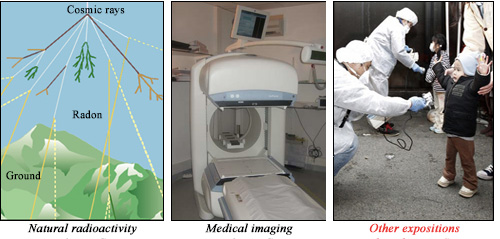Radioactivity surrounds us
All the energy we get from the sun comes from one comparatively simple reaction: the fusion of two hydrogen nuclei into another, heavier nucleus. This reaction, involving the same forces as those responsible for beta radioactivity, is what has allowed elements other than hydrogen to be generated. Without it, the great matter factories of the stars would not be able to build the heavier elements that make up our universe.
Without radioactivity, our planet would have frozen over long ago and life on Earth would be impossible. Radioactive processes in the Earth core slowly release the heat essential for our survival, constantly maintaining the temperate climate we take for granted. All life has developed in a constant shower of radiations, adapting to it and occasionally using it for its own benefit.
Radiations are an omnipresent, inescapable feature of our lives. Whether we go on mountain-climbing expeditions, go down to the cellar to get a bottle of wine, or get aboard a plane, we will always be exposed to it. Even our bodies are radioactive, containing as they do millions of atoms of radioactive substances such as potassium.
Apart from the countless natural sources of exposure, the harnessing of radiation by humanity has led to a multitude of applications that we use every day. Even though the main artificially generated exposure comes from medical examinations (such as X-rays), we use radioactive substances and radiations to sterilise food, prolong its shelf life, and prevent fires in public places…
We must not forget, however, that all these common sources of radiation, whether natural or artificial, remain virtually harmless.

Exposures to radioactivity and radiation
The two main sources of exposure to radiation are natural radioactivity and medicine. A third source is the exposure in case of accidents.
© IN2P3
ACCESS TO SUB-CHAPTERS : SUMMARY
– Natural sources of radioactivity : Its origins and main components. Cosmic rays. Ground radioactivity. Radioactivity of our body and in food.
– Radon, the main source of natural radioactivity : its dangers
– The Sun and sources of the Earth heat : Why does the Sun shine? Why is the Earth so warm?
– Artificial radioactivity : Applications in industry : medical examinations, nuclear power plants, radioactive sources.
– Accidental relases : Atomic bomb tests and accidents : Atomic bombs-fallout, impact on food and human bodies
– Radioactivity and safety controls : Detection of anomalies and controls, detection of drugs and explosives
– Exposure to radiation in flights : Radiation risks while taking a plane.
– Applications of radioactivity in industry, agriculture, food preservation, etc